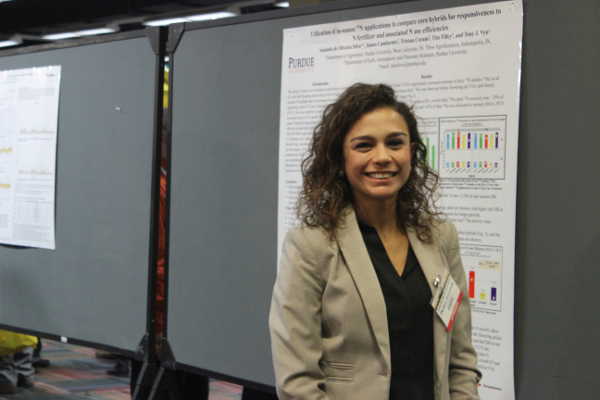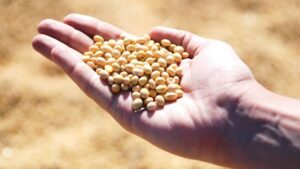This year’s American Seed Trade Association CSS & Seed Expo once again allowed the seed industry to show what it has to offer.
Seed industry stakeholders — and those looking to get a foot in the door — once again showed why they’re known as some of the most innovative and enthusiastic people involved in agriculture at the 2015 American Seed Trade Association Corn, Sorghum and Soybean Seed Research Conference and Seed Expo in Chicago.
Taking place Dec. 7-11, 2015, ASTA president Andrew LaVigne opened the conference with a reminder to attendees that they play a crucial role in telling the story of one of the most important industries on Earth — the seed industry.
“What we do on a daily basis — getting dressed, eating breakfast, spending time with family — starts with seed. Somewhere back there, it began with a seed in the form of feed, fuel and fiber,” LaVigne said. “You are the center of all this. Please remember that. We have a great story to tell.”
One way that story was told was through student posters in the ASTA Innovations Lounge, a new feature of the CSS & Seed Expo. ASTA featured agriculture graduate student poster presentations from across North America.
Cole Stalter of the University of Illinois at Urbana Champaign showcased a project he’s working on looking at the evaluation of plant health effects and tolerance of field corn to the fungicide penthiopyrad (sold by DuPont under the brand name Vertisan) when applied post-emergence.
“I’m here for the networking experience — I’m very interested in plant breeding. There’s a lot of Ph.D and master’s degree students here who know a lot more than I do, and industry professionals I can talk to and ask questions. It’s a way for me to involve myself in the industry I’d like to work in in the future,” he said.
The Innovations Lounge also allowed seed industry businesses like Ohio’s Buckhorn Services to show off their latest products and services.
John Bertilino, national sales manager for Buckhorn Services, unveiled the industry’s first mobile washing service. “We identified several problems the customer base was seeing, and a lot of them said they were having a hard time washing their boxes,” he said. “They can’t get temporary staff in to do their washing, or it’s too labor intensive and slow.”
Container washing generally occurs between June and October as seed companies prepare to distribute seed in the ensuing months. The primary benefit of the mobile washing unit is that it allows seed manufacturers to focus on their core business while reducing transportation expenses and multiple stages of container handling.
The service can do over 60 boxes per hour.
“What we can do in a few days compared to what someone can do with a power washer is significant,” Bertilino said.
Important Issues
The CSS was once again a forum for important issues concerning the seed industry.
AgResource Company president Dan Basse returned for his annual update on the ag economy and the global trends affecting U.S. exports in 2015.
Basse is an economist who has been in the commodity business since 1979. In 1987, he founded AgResource Company, a domestic and international agricultural research firm located in Chicago that forecasts domestic and world agricultural price trends.
It was a world record year in soybean and wheat production, Basse noted. Global wheat, soy and corn demand is not growing at the pace of supply, however, and that means low commodity prices are the result — they’re at a nine-year low. World grain/oilseed markets are seeing tightening annual price ranges. Larger stocks are helping to mute the importance of weather, while cheap energy slows future biofuel grain use, Basse said. Both cause speculators to avoid ag investments, which has an effect on the seed sector.
At the same time, a rising U.S. dollar will fan additional grain production in non-U.S. export regions including Russia, Ukraine, Brazil, Argentina, Australia and Canada.
“If trend yields persist, the world will need to find ways to manage supply,” Basse noted. “Farmers will store as much of their crops as they can, with bankers holding a more important role as to when sales are made.”
Other challenges are on the horizon as well. Basse referred to the often-cited United Nations statistic that the world population will grow to 9 billion by 2050, and noted that 2015 is the first year since the Second World War that the world population will not grow.
“According to the UN and FAO, world population numbers this year will decline. By the time we have 9 billion people, it will be somewhere north of 2065,” he said. That means production is higher than demand, leading to uncertainty in agriculture markets.
Great Need to Improve Wheat Breeding Efficiency
Although genetically modified traits often capture headlines, phenomics, sensor technology, and biometrical modeling is transforming wheat breeding. That was one of the messages from the session “Wheat Today and Tomorrow: Addressing Agronomic Challenges Through Genetics”.
Wheat breeding has historically benefited from advances in disciplines outside of wheat breeding, noted Ed Souza, global wheat breeding manager for Bayer CropScience.
“Predicting the future is difficult,” Souza said. “In the 1960s the average [wheat] yield globally was about 1.5 tons per hectare. Now, it’s about three tons her hectare. The question is how did we get from A to B? If you look at it, there are a number of things that have contributed to it. One that we often talk about is the grain revolution. In fact, there are additional revolutions that have happened during the career of most people in this room.”
Improving the basic yield of crops remains a complex task for trait development and breeding improvement. Understanding complexity of traits, genetic basis of yield components and impact of environmental effects will help to generate new seed products, he said.
Clay Sneller, Ohio State University professor in plant breeding and genetics, spoke about how the genetic improvement of wheat, like most crops, is based on a foundation of old tried and true methods, but is also increasingly able to utilize new genomic technologies.
This combination of new and old offers some exciting potential, but limits remain as to what can be accomplished and when. His talk highlighted some of the challenges facing wheat improvement and what we can expect from some emerging technologies.
“We’re losing thousands of acres in wheat in Ohio and Indiana every year, and that’s disturbing,” he said. “Wheat is hugely important, but farmers don’t seem to feel it’s as important — they’re moving to corn and soybeans. How do we get growers back into wheat?”
Researchers at Ohio State University have boosted and improved wheat yields due to genetic improvements, which he said could convince farmers to get back into growing wheat.
The challenge? Picking the right parents for breeding and creating new tools to help in wheat breeding. His conclusion: traditional plant breeding is an inefficient method of improving wheat, but there are lots of tools available, and genomic selection may help.
Anti-Science? No Such Thing
Helping close the conference was Washington Post columnist Tamar Haspel, who addressed attendees about the barriers to effective communication about science, and how we can overcome them. The presentation offered new strategies pertaining to the challenges of communicating effectively on some of the hotly debated issues surrounding modern agriculture.
Why is it that partisans on both sides of contentious issues — GMOs, climate change, fracking, and so many others — seem to talk past each other? The scientists who study how humans make decisions are giving us some compelling, actionable answers to that question. And the results might not be what you think, she said.
“David Hume said it best 300 years ago when he noted that reason is a slave to the passions,” she said. “Confirmation bias rules the human psyche. We’re all navigating a world looking for ways to support our version of what truth is. When facts that don’t confirm our worldview, we have all these diabolical mechanisms to dismiss those facts.”
What’s frustrating, she said, is that we can easily see when other people do this, but we have a very hard time noticing when we ourselves are guilty of this.
“The simple fact is that facts are not persuasive. There are so many mechanisms we have to filter them out.”
It may seem counterintuitive for humans to consciously dismiss facts, but according to Haspel, it makes sense. Humans did not evolve in the presence of data, but rather in the absence of it.
“Data itself hasn’t been around very long. Humans evolved with cultural and religious practices, family values — not data.”
Haspel used the GMO debate as an example of a conversation where people on both sides of the fence often dig in their heels and dismiss information that contradicts their worldview.
“Surprisingly, the more you know about science, the more your politics will determine your opinion on this issue,” she said. “Education doesn’t protect you. The better educated you are, the better you are at dismissing things you don’t agree with.”
So how do we have a constructive conversation about organic agriculture, GMOs or other controversial issues that concern the seed industry?
“Reconsider the word ‘bias’. The question isn’t how do we eliminate it, but how do we take it into account?”
She also cautioned against labeling anyone as “anti-science.”
“Don’t ever use that word. It gets us nowhere. In the history of the world, no one has ever taken a position they believed to be anti-science. People see the science in light of what their beliefs are. This idea that the science is clear and your [position is correct] could be true. You could have the science on your side, but that doesn’t make the person disagreeing with you anti-science.”
Haspel recommends that people on both sides of the argument — whether it be GMOs, organic agriculture, or another controversial issue — sit down and simply talk.
“Find the smartest person you know who disagrees with you and have a conversation. People who disagree with us often have something in common with us. Reach across the aisle. Make sure when you all get together in a room that you don’t all have the same point of view and are all reinforcing that worldview.”













